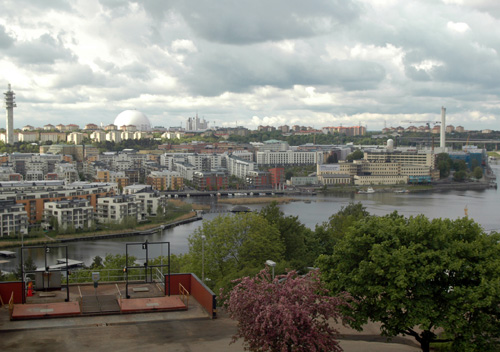
from Sweden vol. 41 2008.08.29 Sustainable City - A sustainable society can be realized!
![]()
The world is coming to a turning point. Global warming continues to draw the attention of great many people, and it has now become an urgent political, economical task for many nations across the world. And in the near-term more and more people will become committed to activities that will help realize a "sustainable society. " A "sustainable society" refers to a society where people all around the world (a world where the global population is said to reach 9 billion by year 2050) use and recycle the Earth's limited resources ingenuously, all the while improving (or maintaining) the "quality of life." Scandinavian countries began their efforts to realize this "sustainable society" years ago, way in advance of the rest of the world. For this report, I visited Stockholm, the capital of Sweden, which is a representative environmentally advanced nation. I was truly taken by surprised by the super advanced and sensible sustainable city that lay before me.
Back to Table of Contents Hammarby Sjostad's Challenge
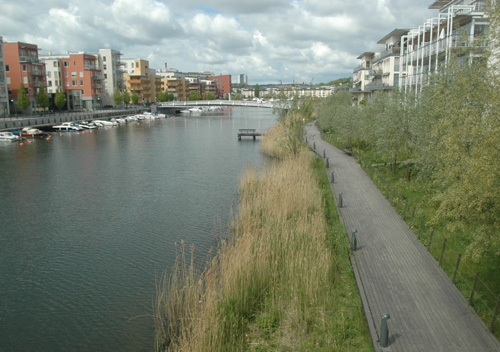 The boardwalk near the tranquil waterside.
The boardwalk near the tranquil waterside.
Hammarby Sjostad is a city by the water located in southeastern Stockholm. The redevelopment plans for this bay area is one of the largest urban redevelopment plans in Stockholm. There is frequent urban redevelopment in Japan as well, but you would usually imagine a commercial metropolis with skyscrapers. What is unique about Hammarby is that a huge area of 200 hectares is being comprehensively redeveloped as a "sustainable city."
Stockholm was originally planning to bid for the 2004 Olympic Summer Games, and there were plans for Hammarby to serve as the "athletes' village that is environmentally conscious on every front." Although Stockholm wasn't able to successfully bid for the Olympic Games, the city decided to push on ahead with its project to redevelop Hammarby as a sustainable city.
The development plans for Hammarby remains wholeheartedly committed to the "sustainability" concept, and aim to reduce the environmental impact to half the levels in the mid 1990s. And by 2017, Hammarby will become a city where 25,000 people live and work. As of 2008, the city already has more than 10,000 inhabitants, and it seems to already be functioning well as a city. Since development began, Hammarby has been serving as the most advanced model of a sustainable city, and over 10,000 specialists and leaders of various field come visit the city from all over the world each year.
The city aspires to reduce environmental impact to half the levels in the mid 1990s, and in order to achieve this goal, it has set clear targets with respect to land use, transportation, building materials, energy, water and sewage, waste, etc.
This is only one of the many examples there are, but in terms of land use, "it aims to reserve over 15% of the land that receives at least 4-5 hours of sunshine in spring and fall as an inner courtyard," with transportation, "it aspires to help create a society where the major means of transportation for 80% of residents will be public transportation, walking or bicycles." Moreover, with respect to energy use, "all heating will use either residual heat or renewable energy;" with water, "the city aims to help reduce the use of 100 liters of water per person per day;" and lastly, regarding waste, "the city hopes to use 80% of organic food waste as fertilizers or bio energy." All of these are very concrete and ambitious targets.
Back to Table of Contents Lifestyle in a sustainable city
 A view of the housing. The environmental impact will be reduced to half the levels in mid 1990s.
A view of the housing. The environmental impact will be reduced to half the levels in mid 1990s.
 Mr. Fredrik Moritz and his son, Hector.
Mr. Fredrik Moritz and his son, Hector.
I went and visited Mr. Fredrik Mortiz's home. He lives in the apartment complex located in Hammarby. Let's take a look at his home to get an idea of how resources are being recycled.
 A gas stove that uses biogas. Mr. Moritz says that it's quite an ordinary product you can find in any store.
A gas stove that uses biogas. Mr. Moritz says that it's quite an ordinary product you can find in any store.
 On the roof there are solar water heaters and solar battery panels.
On the roof there are solar water heaters and solar battery panels.
First of all, the windows are triple-paned and super insulated walls are used. There are some buildings that even incorporate passive solar technology. And on the rooftops of apartment complexes, there are solar battery panels and solar water heaters that help monitor temperatures and generating capacity. Additional power necessary may be purchased from power companies. And in Sweden you can choose to purchase natural power generated from solar batteries, wind power, etc (and what's more, you can purchase power that has been generated by wind power generators you've jointly invested in, at a 50% discount!).
 Once you separate the organic waste from flammable waste, you place the waste into the appropriate pipes. There is a computer-controlled mechanism within and the waste is suctioned down to the central waste collection plant.
Once you separate the organic waste from flammable waste, you place the waste into the appropriate pipes. There is a computer-controlled mechanism within and the waste is suctioned down to the central waste collection plant.
 Joint waste depository. There are many different categories into which trash must be separated.
Joint waste depository. There are many different categories into which trash must be separated.
When the organic waste is collected at the central waste collection plant, it is transformed into fertilizer, which is then used by farmers near Stockholm to grow vegetables and other produce. And there is a joint waste depository where you can separate paper, glass, electrical parts, and other waste into quite specific categories to reuse them as resources. The sewage from toilets and kitchens are collected at the sewage treatment plant to create biogas. The biogas is then supplied to people's homes to be used for biogas cooking stoves. Water treated at the sewage plant goes through a heatpump for heat exchange, which is then used for regional heating and cooling, and finally deposited into the sea. Flammable waste is sent off to a cogeneration plant to create electricity, and the excess heat emitted when the waste is burned is used for regional heating.
 There is a vegetable plot for each housing, so you have a lifestyle with a bit of farming.
There is a vegetable plot for each housing, so you have a lifestyle with a bit of farming.
Once you take a step outside, you will see buses that run on biogas, and rows of environmentally conscious products in the super markets. Even rainwater stored is directly deposited into the sea rather than into the sewage systems. And rainwater that has fallen on the streets is first purified with sand before being deposited into the sea.
 Products bearing the "environmental label" line the shelves in the super markets in town.
Products bearing the "environmental label" line the shelves in the super markets in town.
 Automatic collection bin for cans and bottles I found at the entrance of the super market. If you push the green button, you can collect the money, or you can opt to donate the money to developing countries by pushing the yellow button.
Automatic collection bin for cans and bottles I found at the entrance of the super market. If you push the green button, you can collect the money, or you can opt to donate the money to developing countries by pushing the yellow button.
So, in a nutshell, it's like this. There are 3 major categories - energy, water, and waste - and a thorough recycling system has been developed for all 3.

Additional electricity necessary is supplied as renewable energy generated by wind power or solar generation. (In Sweden, you can choose to use electricity generated from renewable energy, which is priced the same as nonrenewable energy. What is more, you get a great discount for energy from wind power generation you've jointly invested in!)


What was striking about having visited Mr. Mortiz's home is that it didn't seem like an especially environmentally conscious home. Rather we discovered a lifestyle quite ordinary to Sweden.
The gas stove can be found in any electrical appliance retail outlet, but what is supplied to it isn't natural gas, it's biogas. And although the shower uses water that has been heated by solar heat, the way you'd use it is still the same. There is a panel that displays the amount of energy and there's even a very thoughtful convenient switch at the entrance of your house that allows you to turn the gas and power off, but in principle, the lifestyle is no different than any you'd experience in cities all over the world. As I mentioned above, I was able to witness a "sustainable society" that maintained the quality of life while establishing a good cycle of resources.
I realized that if the infrastructure (city) that supports our lifestyle is, itself, sustainable, then you don't have to restrain yourself or be extremely conscious of a lifestyle that is good for the environment; you can live very naturally, without feeling bad.
Actually, the people who moved to this region didn't all have a high awareness for the environment. Their main reasons for moving was that Hammarby is close to the workplace and Stockholm's city-center, there's nature nearby, and the housing prices were not so different from other areas. Of course living in such a town has offered opportunities to think about the global environment. I am looking forward to seeing what kind of ideas these kids who grew up in this region will think of in the future.
Back to Table of Contents The sewage treatment plant is located in an energy company?!
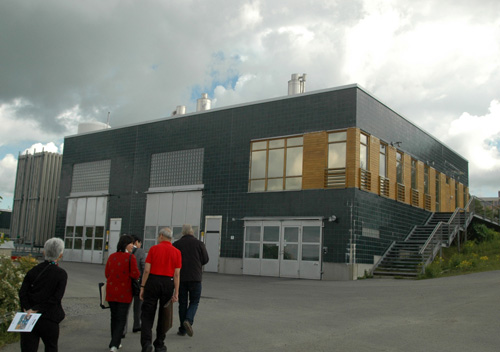 Biogas plant.
Biogas plant.
What is especially unique about the infrastructure that supports Hammarby Sjostad is the sewage plant.
You would imagine that sewage plants collect feces and sewage from homes and treat them to make clean water, but here, they extract the methane gas during treatment. So, the sewage plant serves as a methane gas energy company at the same time. The biogas extracted is provided to homes and is also used as fuel for public transportation such as buses that run through the streets of Stockholm.
 The water purification facility built under a huge bedrock. It was used as a bomb shelter in the past.
The water purification facility built under a huge bedrock. It was used as a bomb shelter in the past.
In Japan, each home produces 10 million tons of organic waste each year. And most of it is burned as waste, but this in itself is such a waste. If you think about organic waste as a source of biogas, the way you look at it will change.
 Mr. Lars Rahm from Stockholm Vatten who guided me through the facilities.
Mr. Lars Rahm from Stockholm Vatten who guided me through the facilities.
Mr. Lars says "energy lies in the city." As more people begin to live in cities (and the more organic waste and toilets the cities have!?), the amount of resource for biogas also increases. Moreover, the composition of biogas is, like natural gas, mostly methane so with a higher degree of purity, you can make use of all of the infrastructure already in place for natural gas. In Europe, there are over 200 gas supply points on the natural gas network, and there are 5.5 million vehicles running on gas. So you can use this infrastructure to implement more biogas.
With better technology, more widespread infrastructure, and better efficiency, building a society that is not dependent on fossil fuels doesn't seem so far fetched. Actually, Stockholm aspires to become a "Fossil Fuel Free City" by 2050.
By 2050, it is said that the world's population will reach 9 billion, and it is estimated that the urban population will be around 5.5 billion by then. So in reality, making cities sustainable is a fundamental task.
Mr. Lars is involved in the research for concentrated liquid biogas technology and also told us of plans to build a new company in the future. It will certainly be a company that will generate new ideas to create energy for the community from resources that may be recycled throughout the region.
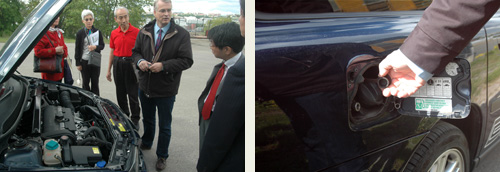 (Left) Mr. Lars' car of course runs on biogas. (Right) There is a gas valve right next to the refueling receptacle.
(Left) Mr. Lars' car of course runs on biogas. (Right) There is a gas valve right next to the refueling receptacle.
Back to Table of Contents Choosing a sustainable future
I felt that in Sweden, it wasn't so much that there were rules saying, "you have to do XX," rather it seemed as though the country provided a wide variety of options that helps you contribute to build a "sustainable society." In other words, people in Sweden are not trying to build a sustainable society because someone is forcing them to or out of a sense of obligation, but they seem to be proactively choosing such a future.
For example, let's look at eco cars. Currently, ethanol and biogas vehicles are available from domestic car manufacturers such as Volvo and Saab, but also from Citroen, Ford, Fiat, Mercedes, and Volkswagen. As infrastructure such as gas supply points are being built, there is an increasing variety of products available in the market, and so even if citizens do not have a high environmental awareness, they can easily choose an eco car. And there are many benefits made available for people who decided on an eco car. For example, when purchasing an eco car, there are subsidies available, and they may be exempt from congestion charges (charged against cars that enter the central area of Stockholm in the morning and evenings during rush hour on weekdays), and they may also get to park their cars for free in the cities. So making a pro-environment choice will result in rewards, and if not, then charges for that decision must be paid. The society presents easy to understand alternatives to the public by using a carrot and stick approach well to help promote a specific action. As a result, as of May 2008, 36% of new cars sold in Sweden are eco cars.
Furthermore, a hamburger shop, MAX, has begun to display CO2 emissions on their menus. So customers can of course decide what they want to eat based on taste and calories, but it can also refer to the environmental impact the individual products have. This is another example of how choices are offered to the public.
Talking about making choices, elections are the same. Sweden has a very high voting rate of 80%. It is also easier than in Japan to send politicians with a high environmental awareness to the national administration. With such a high voting turnout, citizens can feel like they are indeed taking part in leading the country.
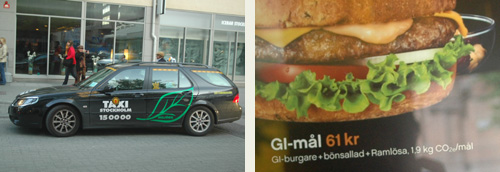 (Left) The leaf mark means that it's an eco taxi running on ethanol or biogas. One out of 4 taxies have these marks.
(Left) The leaf mark means that it's an eco taxi running on ethanol or biogas. One out of 4 taxies have these marks.
(Right) The menu from MAX hamburger shop. Can you see the CO2 emissions written on the menu?
Through my visit to Sweden, I came to believe firmly that a sustainable society is realizable. What is being brought to life in Sweden and other Scandinavian countries is also possible in other countries. The keen awareness for the environment people in Scandinavia and Japan have isn't so different. And the costs of environmental technologies being developed in Japan and in other parts of the world are decreasing. Technology is available and may be implemented economically as well. So you could say that the rest is up to the ingenuity of being able to combine such technologies to form a system and to incorporate the system into society and the political leadership that promotes them. Tackling global warming as well as other environmental issues is becoming a race against time. I hope that Japan will more and more incorporate superior systems developed through trial and error by countries advanced in this aspect and apply them to the development of a sustainable society.
Report and original Japanese text written by: Soichi Ueda (Think the Earth Project)
Translated by: Yuri Morikawa (oxygen inc.)
Photographs by: Soichi Ueda (Think the Earth Project)
Cooperation: Sachiko Takami (Representative of Natural Step Japan)















